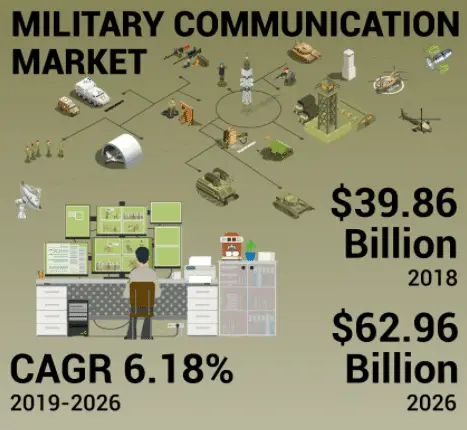The global military communication market is set to gain traction from the increasing adoption of satellite communication (SATCOM) technology. This technology aids in achieving ship-to-shore, ship-to-ship, air-to-ground, and air-to-air communications. It also provides tactical communication that can be easily integrated on aircraft, naval vessels, and vehicles. This information is published by Fortune Business Insights™ in a recent report, titled, “Military Communication Market Size, Share and Industry Analysis by Component (Hardware and Software), By Technology (SATCOM, VHF/UHF/L-Band, HF Communication, and Data Link), By Platform (Airborne, Ground, Naval, and Space), By Application (Command and Control, Intelligence, Surveillance, and Reconnaissance (ISR), Situational Awareness, Routine Operations, and Others), and Regional Forecast, 2019-2026.” The report further mentions that the military communication market size was USD 39.86 billion in 2018 and is projected to reach USD 62.96 billion by 2026, thereby exhibiting a CAGR of 6.18% during the forecast period.
The emergence of COVID-19 has brought the world to a standstill. We understand that this health crisis has brought an unprecedented impact on businesses across industries. However, this too shall pass. Rising support from governments and several companies can help in the fight against this highly contagious disease. There are some industries that are struggling and some are thriving. Overall, almost every sector is anticipated to be impacted by the pandemic.
We are taking continuous efforts to help your business sustain and grow during COVID-19 pandemics. Based on our experience and expertise, we will offer you an impact analysis of coronavirus outbreak across industries to help you prepare for the future.
Drivers & Restraints-
Rising Investment in Military Worldwide to Accelerate Growth
In the defense sector, maintenance of consistent communication and protection of highly confidential information are two of the major requirements. Inaccurate transfer of real time data and leakage of crucial data may result in disputes and pose a risk to the safety of the masses worldwide. Defense communication is often dependent on a vast and complex network of software and hardware components for conveying the messages across the globe. In addition to that, it consists of all the aspects related to the transmission of information by military forces for well-organized control, command, military surveillance, and functioning. The investment in military is likely to upsurge in the coming years because of the rising disputes among various countries. However, such communication is mission-critical in nature. Hence, it may hinder the military communication market growth during the forecast period.
Browse Summary of this Report:
https://www.fortunebusinessinsights.com/military-communications-market-102696
Segment-
Software Segment to Grow Rapidly Backed by Increasing Usage of SDR System
In terms of component, the market is bifurcated into software and hardware. The software segment held 26.5% defense communication market share in 2018 and is expected to grow at a fast pace throughout the forecast period. This growth is attributable to the higher usage of software defined radio (SDR) system in military forces. SDR offers improved functions to the end user. It is also capable of transmitting data, voice, and video across dissimilar systems. Besides, it can integrate cross banding and can perform multi modes operations by utilizing multiple frequency bands.
Regional Analysis-
Rising Commercial Aircraft Deliveries to Favor Growth in Asia Pacific
Based on region, the market is segregated into North America, Asia Pacific, Europe, and the rest of the world. Out of these, North America procured USD 15.35 billion military communication market revenue in 2018. It occurred because of the existence of numerous prominent communication equipment and system manufacturers in this region. Europe is anticipated to grow considerably fueled by the presence of several naval and airborne communication solution manufacturers, namely, Cobham Plc. and Thales Group.
Asia Pacific, on the other hand, is projected to showcase robust growth in the coming years backed by the rising deliveries of commercial aircraft in the developing nations, such as China and India. Apart from that, these countries are experiencing a surge in the military spending to remold their military systems for strengthening the defense sector.
Competitive Landscape-
Key Companies Focus on Mergers & New Contracts to Gain Competitive Edge
The market consists of a large number of companies that persistently striving to achieve more share. They are therefore, aiming to gain new contracts from the Army and Navy and are adopting the strategy of mergers and acquisitions. Below are a couple of the latest key industry developments:
- June 2019: Harris Corporationand L3 Technologies declared that they are merging to form a new company called L3Harris Technologies. The new company would is set to become the tenth largest defense company worldwide. It is set to house around 48,000 employees.
- February 2016: Harris Corporation, Rockwell Collins, and General Dynamicswere awarded a new contract from the Army to develop Manpack radios. These will be carried in rucksacks or mounted on vehicles.
0






